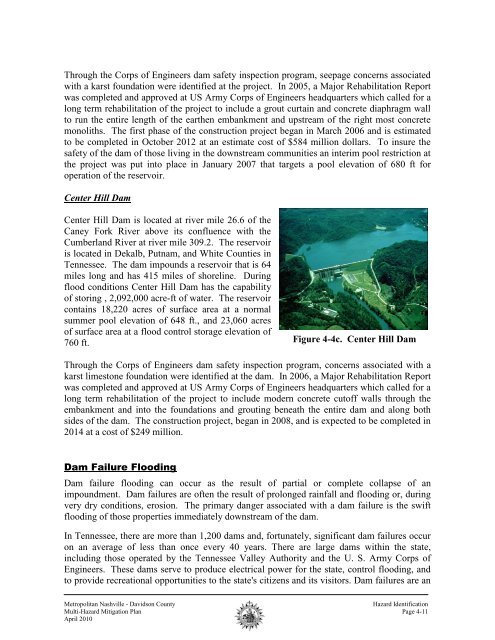2010 Metro Mitigation Plan
2010 Metro Mitigation Plan
2010 Metro Mitigation Plan
Create successful ePaper yourself
Turn your PDF publications into a flip-book with our unique Google optimized e-Paper software.
Through the Corps of Engineers dam safety inspection program, seepage concerns associated<br />
with a karst foundation were identified at the project. In 2005, a Major Rehabilitation Report<br />
was completed and approved at US Army Corps of Engineers headquarters which called for a<br />
long term rehabilitation of the project to include a grout curtain and concrete diaphragm wall<br />
to run the entire length of the earthen embankment and upstream of the right most concrete<br />
monoliths. The first phase of the construction project began in March 2006 and is estimated<br />
to be completed in October 2012 at an estimate cost of $584 million dollars. To insure the<br />
safety of the dam of those living in the downstream communities an interim pool restriction at<br />
the project was put into place in January 2007 that targets a pool elevation of 680 ft for<br />
operation of the reservoir.<br />
Center Hill Dam<br />
Center Hill Dam is located at river mile 26.6 of the<br />
Caney Fork River above its confluence with the<br />
Cumberland River at river mile 309.2. The reservoir<br />
is located in Dekalb, Putnam, and White Counties in<br />
Tennessee. The dam impounds a reservoir that is 64<br />
miles long and has 415 miles of shoreline. During<br />
flood conditions Center Hill Dam has the capability<br />
of storing , 2,092,000 acre-ft of water. The reservoir<br />
contains 18,220 acres of surface area at a normal<br />
summer pool elevation of 648 ft., and 23,060 acres<br />
of surface area at a flood control storage elevation of<br />
760 ft.<br />
Figure 4-4c. Center Hill Dam<br />
Dam<br />
Through the Corps of Engineers dam safety inspection program, concerns associated with a<br />
karst limestone foundation were identified at the dam. In 2006, a Major Rehabilitation Report<br />
was completed and approved at US Army Corps of Engineers headquarters which called for a<br />
long term rehabilitation of the project to include modern concrete cutoff walls through the<br />
embankment and into the foundations and grouting beneath the entire dam and along both<br />
sides of the dam. The construction project, began in 2008, and is expected to be completed in<br />
2014 at a cost of $249 million.<br />
Dam Failure Flooding<br />
Dam failure flooding can occur as the result of partial or complete collapse of an<br />
impoundment. Dam failures are often the result of prolonged rainfall and flooding or, during<br />
very dry conditions, erosion. The primary danger associated with a dam failure is the swift<br />
flooding of those properties immediately downstream of the dam.<br />
In Tennessee, there are more than 1,200 dams and, fortunately, significant dam failures occur<br />
on an average of less than once every 40 years. There are large dams within the state,<br />
including those operated by the Tennessee Valley Authority and the U. S. Army Corps of<br />
Engineers. These dams serve to produce electrical power for the state, control flooding, and<br />
to provide recreational opportunities to the state's citizens and its visitors. Dam failures are an<br />
<strong>Metro</strong>politan Nashville - Davidson County<br />
Hazard Identification<br />
Multi-Hazard <strong>Mitigation</strong> <strong>Plan</strong> Page 4-11<br />
April <strong>2010</strong>


